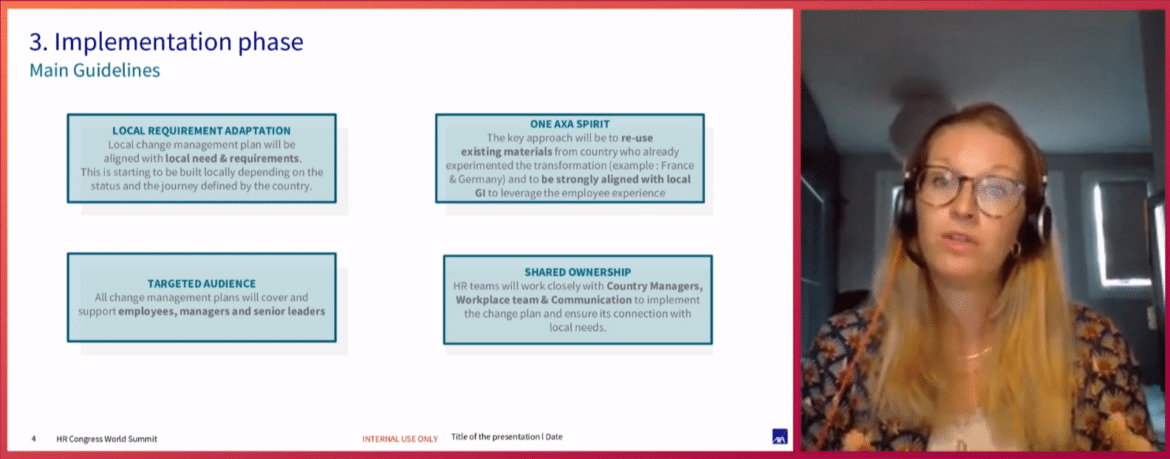
AXA XL’s Hybrid Working Success: A Blueprint for Creating a Thriving Work Culture
today2023.04.27. 497

WHY SHOULD YOU CARE?
AXA XL’s successful implementation of hybrid working involved identifying different employee personas and addressing their unique needs. The company adopted policies and benefits based on employee feedback and fostered local initiatives to support mental health and work-life balance. The success of the hybrid working approach is evident in AXA XL’s ability to attract and retain talent, setting an example for other organizations seeking to create a hybrid culture that values productivity and employee engagement.
AXA XL, a multinational insurance firm, has undergone significant transformation due to the pandemic. Aymeline Gour Chauvancy, Learning and Development Manager for APAC and Europe shared her company’s journey at The HR Congress World Summit about changing their methods of working by adopting hybrid working.
2020 brought with it rapid and unprecedented change, which amplified established trends such as workplace digitization and flexible work models. VUCA – or a more fashionable term of BANI – environments have become the new norm and require individuals to adopt an attitude of learning while being open to accepting change.

Employees have also expressed a wish for greater flexibility and balance between professional and personal lives, so AXA XL identified three areas impacted by this new environment.
First and foremost is creating the appropriate culture for hybrid ways of working, which requires both structure and flexibility. Second is employee well-being as remote work can often cause overconnection or blurred lines between work and personal life. Finally, leadership for engagement plays an essential role in more sustainably engaging employees in company goals and reconnecting them to its purpose.
AXA XL’s mission is to advance human progress by safeguarding what matters. They do this by helping their colleagues realize their full potential and drive forward change. Smart working, or hybrid working, provides a better balance between work and personal life while still guaranteeing long-term productivity.
How has AXA XL managed its transformation successfully?
They did this by emphasizing building a hybrid culture with clear structures and flexibility, as well as emphasizing change management needs while emphasizing learning mindset development for their leaders.
Employee well-being was also of great importance at AXA XL. They provided training on managing virtual teams and maintaining work-life balance, encouraging employees to take breaks when needed and take breaks when feeling overwhelmed or exhausted. In addition, they established an Employee Assistance Program virtual support mental health and well-being.
The company highlighted the significance of leadership and engagement by investing in leadership development programs for their managers and providing them with all of the tools and resources necessary for leading in a hybrid environment. They also encouraged regular communication between teams so as to maintain an awareness of connection and purpose among them.
From working to smart working
Implementation of a smart working policy across AXA entities worldwide was a crucial decision early on by the group, as this policy drew heavily on lessons learned during remote working deployment during the pandemic and its success; ultimately ensuring operational continuity.

AXA implemented an innovative strategy in which all employees had the choice between remote working and office presence, with an average of two days each week spent working from home. This was an empowering shift for AXA as they transitioned away from remote to hybrid working models.
Though AXA had some work-from-home policies in place prior to the pandemic, its move towards a hybrid working model was new. This meant teams in different countries might each work from home for two days per week – sometimes on different days than their coworkers and potentially not seeing each other for weeks at a time. AXA needed to plan how everyone would collaborate effectively within such a dynamic working environment.
To implement its policy effectively, AXA needed to devise guidelines that were inclusive for everyone rather than generic. Local requirement adaptation was one such guideline that enabled each country within the region to drive change according to its unique culture, regulations, and maturity levels.
AXA recognized that in order for their policy to succeed, AXA needed to target different parts of the company with specific change management plans tailored specifically to employees, managers, and senior leaders. While AXA initially started by targeting HR team employees only, as time progressed they recognized they needed to target different sections of the population for optimal success of policy implementation.
The third guideline was One AXA Spirit, in which an employee experience was consistent across all entities of AXA. Given AXA is such a large company, liaising with each local entity in each country allowed AXA to share best practices and align themselves with what already existed there – creating a homogenous way of working and consistent employee experiences across its entirety.
Implementation of AXA’s smart working policy was no small task in APAC and Europe with 15 countries boasting different cultures, regulations and maturity levels; yet they were successful at doing it anyway, becoming part of their standard operating procedure now.

Aymeline explained that smart working is more than simply implementing work-from-home policies; it involves adapting workplace environments for hybrid work styles, improving technology for online meetings and collective sessions, as well as working collaboratively across both physical and remote teams. Shared ownership and collaboration are critical in making smart working work, so she highlighted their four guidelines to guide this project and toolbox that country leaders and HR managers could utilize at will; further emphasizing aligning it with the company culture of trust, collaboration, and empowerment.
Aymeline noted that implementation of smart working policies varied between their 15 countries of operation, each country having its own return to work deadline. They created a toolbox focusing on three main topics – employee, manager, and senior leader – in order to equip HR teams and managers in driving transformation within their teams. Speaker stated they focused more on equipping employees with tips and toolkits for time-efficient work at home or the office as well as good practices for inclusion and fairness hybrid meetings; additionally promoting a disconnected policy so employees feel safe spending their own free time outside of work!
She explained to Managers that they supported them in leading their teams by equipping them with tools from LinkedIn Learning, sharing moments with leaders to discuss strategy and understand key messages, as well as live training on smart working which covered topics such as trust building, positive management and fairness within teams.
AXA XL’s change plan for creating a hybrid work environment emphasized the need to ensure everyone remains connected.
To achieve this goal, they implemented initiatives and policies designed to foster collaboration and teamwork, such as team agreements that allowed managers and team members to determine together how they wanted to collaborate and remain connected.
Furthermore, they offered training sessions to help their employees adjust to virtual and hybrid environments; newcomers may find it challenging to feel welcomed when they don’t see everyone immediately upon joining. Furthermore, the company was attentive to employee feedback by regularly conducting surveys in order to better understand employee needs and preferences; this enabled them to adapt policies and initiatives as necessary in order to better support employees.
AXA XL was committed to supporting their employees’ well-being and mental health during the transition to smart working, using local initiatives and external resources. For instance, each country in their region offered an employee assistance program as a source of help if employees were experiencing any mental health challenges; these external providers were available free of charge – providing employees with a confidential platform through which to speak out if necessary.
Additionally, the company placed great importance on disconnecting from work and striking a healthy balance between work and personal life. This was evident through policies and initiatives such as permitting employees to disconnect outside of working hours as well as encouraging managers to set boundaries between personal life and professional responsibilities.
Finally, AXA XL understood that providing hybrid working options was key in attracting and retaining talent. They recognized that both new-generation workers, as well as older ones, needed flexible ways of working that could fit their personal and professional lives seamlessly; offering hybrid options allowed AXA XL to meet these demands while staying competitive in the market.

Overall, AXA XL’s experience implementing smart working demonstrates its significance by emphasizing the balance between remote and in-person interactions, empowering managers and employees to define how they collaborate, staying attentive to employee feedback, supporting employees’ mental health and well-being needs, emphasizing disconnecting from work when possible and offering flexible working options. These lessons learned can be applied by other organizations looking to implement similar policies or make adjustments within existing policies and initiatives.
The implementation of hybrid working has been an immensely productive and ongoing process that required shared ownership to succeed. Recognizing the evolving demands of the modern workforce, AXA XL took steps to develop an employee culture that supports productivity and employee engagement while striking a balance between remote work and in-person interactions.
AXA XL’s change plan involved several key components, beginning with the identification of various personas and their needs. This allowed the company to tailor solutions that met individual group challenges more effectively. Managers were empowered to lead effectively within hybrid environments while colleagues were encouraged to define how they wished to collaborate through team agreement approaches. Senior leaders played key roles as role models by emphasizing a hybrid culture while driving transformation from a business perspective.
The company’s experiences from its hybrid working implementation were instrumental in supporting change and meeting employees’ evolving needs. They kept an ear out for employee feedback, adapting policies and benefits accordingly, as well as encouraging local initiatives for creating collective experiences, supporting mental health, and well-being, and maintaining a balance between professional and personal lives.
The Hybrid working implementation has proven its worth by drawing in and retaining talent – including younger employees seeking more flexible forms of employment. AXA has set an exemplary example for organizations looking to adapt to today’s workforce needs while cultivating an employee engagement culture with high productivity levels.

Written by: Mihaly Nagy
Culture Employee Engagement Employee Experience HR Transformation Hybrid Working Leadership
Previous post

- 510
labelArticles today2023.04.26.
Beyond the 4-Day Work Week: Designing Workplaces for Personalization and Growth
WHY SHOULD YOU CARE? In a world where the future of work is constantly changing, it’s important to take a step back and ask ourselves some fundamental questions about our [...]
Similar posts

labelArticles today2024.10.21.
The success-recipe to build agile and future-ready organizations in 2025 and beyond







Post comments (0)